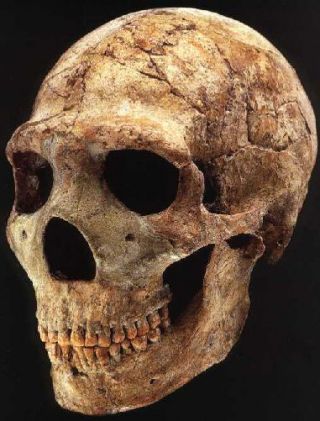Intelligence
Does Brain Size Matter?
Exploring brain and body relationships in Neandertals and Homo sapiens
Posted September 21, 2013
By Professors Thomas Wynn and Frederick L. Coolidge
At the end of our first blog post we left readers with a provocative fact about Neandertals: Neandertal brains were different from ours. We have no living Neandertal brains; indeed, we have no Neandertal brains per se, so how do we know this? We know it Neandertal from brain cases, from which we can determine overall brain size and also overall brain shape (by means of an endocast, a measurement of the shape of the brain from the inside of the skull). As an individual matures from infancy to adulthood, the upper part of the brain case expands as the growing brain exerts pressure from the inside. In a sense, the brain pushes out the cranial vault and, as a result, the internal shape of the brain case preserves the shape of the brain. Neandertal brains did differ from modern brains in both size and shape. Let’s first look at size.
Neandertal brains were bigger than modern brains, about 10% bigger. Modern brains average about 1300cc; Neandertals averaged about 1430cc. We must be cautious here. We do not have a large number of Neandertal crania, only 28 complete enough for a reliable measurement of volume, and it is possible that by chance we have found some big ones (the Amud Neandertal from Israel had a cranial capacity of 1740cc, for example, about 400cc above the modern average – see the accompanying picture). Also, Neandertals were heavily muscled, and some of the increase in brain size may reflect their body size; indeed brain size correlates with lean muscle mass more than it does with fat. However, given Neandertals’ short stature and overall weight (180 – 200 lbs.; more on this in a future post) this strikes us as unlikely. Most anthropologists accept that Neandertals had slightly larger brains, on average, than modern people. But were they 10% smarter? Smarter, obviously, is a loaded question. Neandertals survived successfully for over 200,000 years. Within about 10,000 years, with the influx of Homo sapiens into Europe at about 40,000 years ago, Neandertals went extinct. As we hinted in our first blog, it is strongly suspected that it was the behavior of the incoming Homo sapiens that may have had more to do with Neandertal’s extinction and not necessarily something inherent in Neandertal behaviors. But more about that in a later blog.
When we compare animals to one another there is a correlation between relative brain size and performance on intelligence tests. But we have to consider body size, because large animals need larger brains to monitor and run their large organs and higher number of nerve endings. Any measure of brain size must take into account the size of the body. When we factor out body size, some animals (fish, reptiles) still have very small brains, and others (mammals, birds) have large brains. As you might predict, fish and reptiles do poorly on intelligence tests. When we compare mammals to one another, some have relatively small brains (horses, moles), and others large brains (primates, dolphins), and even here there appears to be some correlation with intelligence. But when we compare primates to one another the ‘size = intelligence’ equation is harder to justify. All are relatively large brained, and all are pretty smart (in India, for example, teams of macaque (an Old World monkey) work together to distract and rob people on the streets). But there is one primate that is very different – humans. Our brain is about three times bigger than it should be for our body size. And we can devise tests that no other primate can pass. So brain size is not irrelevant. But does brain size correlate with intelligence if one compares modern people to one another? The answer, thankfully, appears to be no. There is no clear correlation between brain size and intelligence in modern people. Finally, raw brain volume (size) may not accurately reflect the number of brain neurons (which just may be a critical component of intelligence), or the size of any other functional unit of the brain.
So, what about the bigger-brained Neandertals? We have established that brain size alone doesn’t predict intelligence in modern folk, and it probably didn’t predict intelligence in our cousins, the Neandertals, and Homo sapiens living at that same time. There is actually something about Neandertal brains that is more informative than size. Neandertal brains were shaped differently, and we will address the issues surrounding the shapes of brains in our next blog.
Interested in taking an undergraduate or graduate online course (for credit or non-credit) about Neandertals from the University of Colorado’s Center for Cognitive Archaeology? Contact the Extended Studies Coordinator Brian Glach (bglach@uccs.edu) for details.

The Amud (Israel) Neandertal Skull


